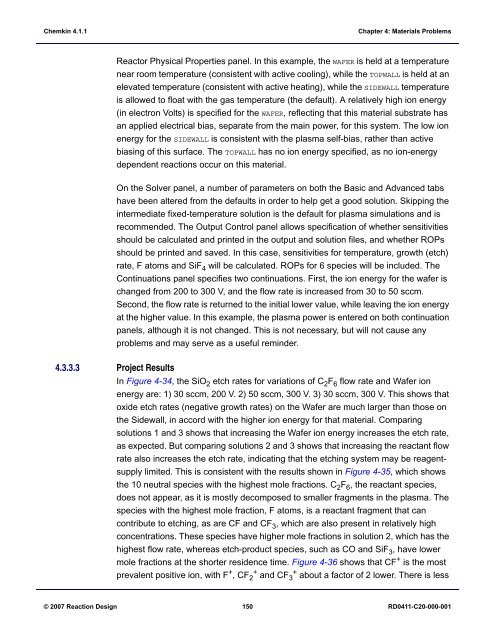Tutorials Manual
Tutorials Manual
Tutorials Manual
You also want an ePaper? Increase the reach of your titles
YUMPU automatically turns print PDFs into web optimized ePapers that Google loves.
Chemkin 4.1.1<br />
Chapter 4: Materials Problems<br />
Reactor Physical Properties panel. In this example, the WAFER is held at a temperature<br />
near room temperature (consistent with active cooling), while the TOPWALL is held at an<br />
elevated temperature (consistent with active heating), while the SIDEWALL temperature<br />
is allowed to float with the gas temperature (the default). A relatively high ion energy<br />
(in electron Volts) is specified for the WAFER, reflecting that this material substrate has<br />
an applied electrical bias, separate from the main power, for this system. The low ion<br />
energy for the SIDEWALL is consistent with the plasma self-bias, rather than active<br />
biasing of this surface. The TOPWALL has no ion energy specified, as no ion-energy<br />
dependent reactions occur on this material.<br />
On the Solver panel, a number of parameters on both the Basic and Advanced tabs<br />
have been altered from the defaults in order to help get a good solution. Skipping the<br />
intermediate fixed-temperature solution is the default for plasma simulations and is<br />
recommended. The Output Control panel allows specification of whether sensitivities<br />
should be calculated and printed in the output and solution files, and whether ROPs<br />
should be printed and saved. In this case, sensitivities for temperature, growth (etch)<br />
rate, F atoms and SiF 4 will be calculated. ROPs for 6 species will be included. The<br />
Continuations panel specifies two continuations. First, the ion energy for the wafer is<br />
changed from 200 to 300 V, and the flow rate is increased from 30 to 50 sccm.<br />
Second, the flow rate is returned to the initial lower value, while leaving the ion energy<br />
at the higher value. In this example, the plasma power is entered on both continuation<br />
panels, although it is not changed. This is not necessary, but will not cause any<br />
problems and may serve as a useful reminder.<br />
4.3.3.3 Project Results<br />
In Figure 4-34, the SiO 2 etch rates for variations of C 2 F 6 flow rate and Wafer ion<br />
energy are: 1) 30 sccm, 200 V. 2) 50 sccm, 300 V. 3) 30 sccm, 300 V. This shows that<br />
oxide etch rates (negative growth rates) on the Wafer are much larger than those on<br />
the Sidewall, in accord with the higher ion energy for that material. Comparing<br />
solutions 1 and 3 shows that increasing the Wafer ion energy increases the etch rate,<br />
as expected. But comparing solutions 2 and 3 shows that increasing the reactant flow<br />
rate also increases the etch rate, indicating that the etching system may be reagentsupply<br />
limited. This is consistent with the results shown in Figure 4-35, which shows<br />
the 10 neutral species with the highest mole fractions. C 2 F 6 , the reactant species,<br />
does not appear, as it is mostly decomposed to smaller fragments in the plasma. The<br />
species with the highest mole fraction, F atoms, is a reactant fragment that can<br />
contribute to etching, as are CF and CF 3 , which are also present in relatively high<br />
concentrations. These species have higher mole fractions in solution 2, which has the<br />
highest flow rate, whereas etch-product species, such as CO and SiF 3 , have lower<br />
mole fractions at the shorter residence time. Figure 4-36 shows that CF + is the most<br />
prevalent positive ion, with F + + +<br />
, CF 2 and CF 3 about a factor of 2 lower. There is less<br />
© 2007 Reaction Design 150 RD0411-C20-000-001
















